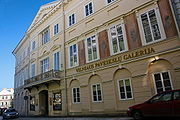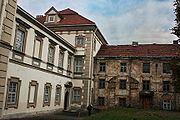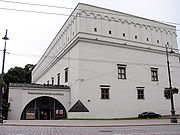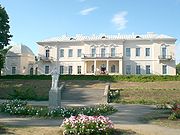
Lithuanian Art Museum
Encyclopedia


Vilnius
Vilnius is the capital of Lithuania, and its largest city, with a population of 560,190 as of 2010. It is the seat of the Vilnius city municipality and of the Vilnius district municipality. It is also the capital of Vilnius County...
in 1933 as the Vilnius City Museum. It houses Lithuania's largest art collection.
History
The institution's origins can be traced to the early 20th century, when a resurgence of cultural interest followed the end of the ban on the Lithuanian language imposed by the Russian EmpireRussian Empire
The Russian Empire was a state that existed from 1721 until the Russian Revolution of 1917. It was the successor to the Tsardom of Russia and the predecessor of the Soviet Union...
. A number of art exhibitions at that time donated works to the Lithuanian Art Society, which began to make plans for a permanent facility. The activity was interrupted by World War I
World War I
World War I , which was predominantly called the World War or the Great War from its occurrence until 1939, and the First World War or World War I thereafter, was a major war centred in Europe that began on 28 July 1914 and lasted until 11 November 1918...
.
During the postwar era, the plans were re-started. In 1933, the Vilnius Magistracy, an administrative division of the Polish
Second Polish Republic
The Second Polish Republic, Second Commonwealth of Poland or interwar Poland refers to Poland between the two world wars; a period in Polish history in which Poland was restored as an independent state. Officially known as the Republic of Poland or the Commonwealth of Poland , the Polish state was...
government that controlled Vilnius at the time, decided to establish a City Museum. Works of art were collected and stored in various buildings, but were not accessible to visitors. In April 1941, its first exhibitions were held; it was known at the time as the Vilnius State Art Museum. In January 1997, the new government of Lithuania granted the museum its current status as a national museum
National museum
A national museum is a museum maintained by a nation.The following is a list of national museums:-Australia:*Australian National Aviation Museum*Australian National Maritime Museum*, Sydney*Australian War Memorial*Museum Victoria...
; it is now part of the Ministry of Culture.
Branches


Chodkiewicz
The Chodkiewicz family was one of the most influential noble families of Ruthenian descent in the Grand Duchy of Lithuania in the 16th-17th centuries. Chodko Jurewicz, chamberlain to Grand Duke Vytenis was probably ancestor of whole clan and gaved it name Chodkiewicz, meaning "son of Chodzko"...
Palace; the Museum of Applied Art at the Vilnius Castle Complex
Vilnius Castle Complex
The Vilnius Castle Complex , is a group of cultural, and historic structures on the left bank of the Neris River, near its confluence with the Vilnia River, in Vilnius, Lithuania. The buildings, which evolved between the 10th and 18th centuries, were one of Lithuania's major defensive...
; the Radziwiłł Palace in Vilnius; the Palanga Amber Museum
Palanga Amber Museum
The Palanga Amber Museum , near the Baltic Sea in Palanga, Lithuania, is a branch of the Lithuanian Art Museum. It is housed in the restored 19th-century Tiškevičiai Palace and is surrounded by the Palanga Botanical Garden. The museum's collection of amber comprises about 28,000 pieces, of which...
; the Pranas Domšaitis
Pranas Domšaitis
Pranas Domšaitis also Franz Domscheit was a painter.Born in Cropiens, a village in the Kingdom of Prussia near its border with Lithuania, Domšaitis spent his first 27 years as a farmer...
Gallery in Klaipėda
Klaipeda
Klaipėda is a city in Lithuania situated at the mouth of the Nemunas River where it flows into the Baltic Sea. It is the third largest city in Lithuania and the capital of Klaipėda County....
; the Clock Museum in Klaipėda
Klaipeda
Klaipėda is a city in Lithuania situated at the mouth of the Nemunas River where it flows into the Baltic Sea. It is the third largest city in Lithuania and the capital of Klaipėda County....
; and the Exhibition Hall in Juodkrantė
Juodkrante
Juodkrantė with permanent population of about 720 people is a quiet Lithuanian seaside resort village located on the Curonian Spit. A part of Neringa municipality, Juodkrantė is the second largest settlement on Lithuania's part of the spit...
.
Collections
The collections at the museum include about 2,500 paintings dated from the 16th to the 19th Century; these consist mostly of portraits of nobility and clergy of the Lithuanian Grand Duchy from the 16th to the 18th centuries, and religious works from Lithuanian churches and cloisters. Over 8,000 drawings by Italian, German, French, Flemish, Dutch, Polish, English, and Japanese artists from the 15th to the 20th century are represented.The first half of the 20th century has an extensive presence, with over 12,000 works. The collection from the second half of the 20th century features more than 21,000 exhibits. Sculpture collections span the 14th through 20th centuries, with works from a number of European countries. Other notable collections include works done in watercolor and pastel, and photography.

